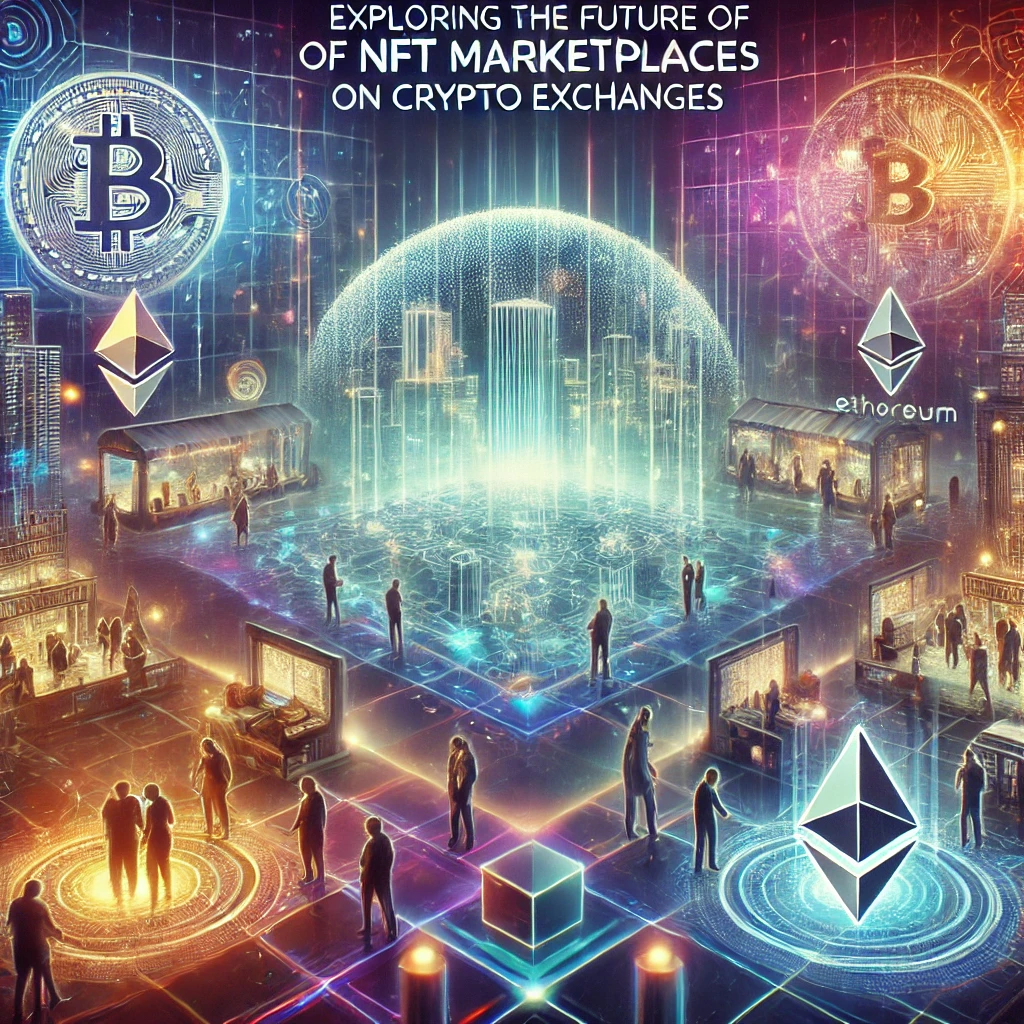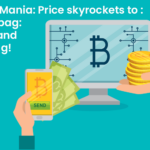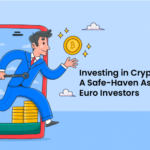Introduction:
The world of non-fungible tokens (NFTs) has taken the digital and financial world by storm in recent years, bringing new possibilities to creators, artists, collectors, and even businesses. Exploring the Future of NFT Marketplaces on Crypto Exchanges. While NFTs started as a niche market for digital art, the rapid expansion of this sector has led to new opportunities for creators and investors. The role of crypto exchanges in the future of NFTs is evolving, with many leading platforms now incorporating NFT marketplaces. As the demand for NFTs continues to rise, these exchanges are adapting to meet the needs of a growing and dynamic community.
In this article, we’ll explore the future of NFT marketplaces on crypto exchanges, diving into the key opportunities, challenges, and trends shaping this space. We’ll also examine how these marketplaces are changing the way digital assets are bought, sold, and traded and what this means for the future of the NFT industry.
1. The Rise of NFTs: A Brief Overview
NFTs are unique digital assets verified using blockchain technology, which ensures their authenticity, scarcity, and ownership. Unlike cryptocurrencies such as Bitcoin and Ethereum, which are fungible and can be exchanged for one another, NFTs represent ownership of a specific asset, such as digital art, music, videos, collectibles, and even real estate.
The emergence of NFTs has been one of the most significant developments in the blockchain world. In 2021, the NFT market exploded, with sales reaching billions of dollars. This surge in popularity prompted crypto exchanges to take notice, and many began integrating NFT marketplaces into their platforms.
As digital art becomes more mainstream, NFTs are offering artists and creators new avenues to monetize their work. They also allow collectors and investors to own rare and valuable digital assets with provable ownership and authenticity.
2. Crypto Exchanges: The New Home for NFT Marketplaces
Previously, NFT marketplaces operated independently of crypto exchanges, with platforms like OpenSea, Rarible, and SuperRare leading the charge. However, as NFTs gained popularity, many crypto exchanges, such as Binance, Coinbase, FTX, and Kraken, recognized the growing demand for NFT trading and decided to launch their own NFT marketplaces.
By integrating NFT marketplaces into their platforms, crypto exchanges are creating more centralized hubs for NFT transactions. Exploring the Future of NFT Marketplaces on Crypto Exchanges. This integration allows users to seamlessly trade NFTs alongside cryptocurrencies like Bitcoin, Ethereum, and other altcoins.
Some of the biggest crypto exchanges have already made significant moves in the NFT space:
- Binance launched its NFT marketplace in June 2021, offering a platform for artists and creators to mint, buy, and sell NFTs.
- Coinbase unveiled its NFT marketplace in 2022, providing a user-friendly interface designed to attract both crypto enthusiasts and newcomers to the space.
- FTX and Kraken are also working to expand their offerings to include NFT trading.
These developments represent a fundamental shift in how NFTs are bought and sold, and they indicate that crypto exchanges are positioning themselves as key players in the NFT ecosystem.
3. Advantages of NFT Marketplaces on Crypto Exchanges
The integration of NFT marketplaces into crypto exchanges offers several benefits for both creators and traders. Here are some of the most significant advantages:
A. Enhanced Liquidity and Trading Volume
Crypto exchanges bring large, established user bases that create a network effect, leading to higher liquidity and trading volume. The vast number of crypto traders on these platforms can seamlessly transition to buying and selling NFTs, leading to more frequent transactions and potentially higher prices for digital assets.
B. Access to a Broader Audience
While standalone NFT marketplaces are often niche, crypto exchanges have millions of active users worldwide. This provides greater exposure for creators, artists, and NFT projects, potentially leading to more sales and higher demand. By listing their NFTs on an exchange, creators can tap into a much larger and diverse audience than they would otherwise reach on independent platforms.
C. Streamlined User Experience
Crypto exchanges are already familiar to a large number of users who trade cryptocurrencies. By adding NFT marketplaces to these platforms, users can easily manage both their crypto and NFT portfolios in a single location, without having to navigate multiple sites. This ease of use is a significant advantage, especially for new users who may be intimidated by the complexity of using separate platforms.
D. Increased Security and Trust
One of the primary concerns in the NFT space is the security of transactions and digital assets. By offering NFT trading on established crypto exchanges, users benefit from the high level of security that these platforms have built over time. With features like two-factor authentication (2FA), secure wallets, and compliance with regulations, crypto exchanges can offer a safer environment for NFT transactions.
4. The Future of NFT Marketplaces: What’s Next?
As the NFT space evolves, the role of crypto exchanges in the marketplace will continue to grow. Here are some key trends and future opportunities that are shaping the future of NFT trading:
A. Integration with Metaverses and Virtual Worlds
The metaverse—a digital universe where people interact, socialize, and conduct business—has become a focal point for the future of NFTs. Virtual worlds like Decentraland, The Sandbox, and Somnium Space are built on blockchain technology and enable users to buy, sell, and trade virtual assets, including NFTs.
Crypto exchanges are increasingly exploring the integration of NFTs into these virtual environments. For example, users could trade NFTs directly within the metaverse, or exchanges could offer a marketplace for virtual real estate and assets in these digital worlds.
B. NFT Fractionalization
Fractionalized NFTs allow multiple investors to own a piece of a single NFT. This concept is gaining traction, as it opens the door to wider participation in the NFT market, especially for high-value assets that might otherwise be out of reach for most individuals.
By listing fractionalized NFTs on their marketplaces, crypto exchanges can help democratize access to digital art, rare collectibles, and other high-value NFTs, allowing smaller investors to participate in the space.
C. Cross-Platform Compatibility
One of the key challenges in the NFT space is the lack of interoperability between different platforms and blockchains. For example, NFTs minted on Ethereum cannot easily be transferred to Solana or Binance Smart Chain. However, as the technology behind NFTs continues to evolve, we may see greater cross-platform compatibility, enabling users to trade NFTs across different blockchains more easily.
Crypto exchanges will play a central role in facilitating these cross-chain transactions, helping to bridge the gaps between various blockchain networks and NFT marketplaces.
D. Regulatory Challenges and Opportunities
As NFTs continue to grow, governments and regulatory bodies are starting to take notice. While the NFT space has largely been unregulated, this is expected to change in the coming years. Governments may impose regulations on NFT trading to prevent fraud, protect intellectual property rights, and ensure fair market practices.
Crypto exchanges that offer NFT marketplaces will need to adapt to these regulations. By staying ahead of the regulatory curve, exchanges can build trust with users and ensure compliance with local laws.
5. Challenges Facing NFT Marketplaces on Crypto Exchanges
While the future looks promising for NFT marketplaces on crypto exchanges, there are several challenges that need to be addressed:
A. Market Volatility
NFT prices can be highly volatile, and the market is prone to speculative bubbles. Crypto exchanges must find ways to protect both creators and investors from the inherent risks of price fluctuations, while also fostering an environment for long-term growth in the NFT space.
B. Scalability Issues
As the demand for NFTs grows, scalability becomes a critical concern. Many blockchain networks, including Ethereum, struggle with high transaction fees and slow speeds during periods of high demand. Crypto exchanges will need to explore more scalable solutions, such as Layer 2 solutions or alternative blockchain platforms, to ensure that their NFT marketplaces can handle growing user demand.
C. Intellectual Property and Copyright Issues
One of the most significant challenges in the NFT space is the issue of intellectual property rights. Because NFTs are linked to digital assets like art, music, and videos, creators must ensure that they have the proper rights to the content they are minting. Crypto exchanges must implement tools to help protect the intellectual property of creators and prevent the unauthorized sale of NFTs.
Conclusion: The Bright Future of NFTs on Crypto Exchanges
NFT marketplaces on crypto exchanges are poised to play a central role in the future of digital assets. With the integration of NFTs into the broader crypto ecosystem, users are benefiting from increased liquidity, security, and ease of access. As blockchain technology continues to evolve, and as the metaverse and fractionalized NFTs become more mainstream, crypto exchanges will continue to adapt and innovate in the NFT space.
For those looking to enter the world of NFTs, now is the perfect time to explore the opportunities offered by these integrated marketplaces. Whether you’re a creator looking to monetize your digital art or an investor looking to diversify your portfolio, the future of NFT trading on crypto exchanges holds immense potential.
Stay updated on the latest trends and developments in the world of NFTs and crypto exchanges with CryptoExchange4U—your trusted source for all things crypto and NFT.






















0 Comments